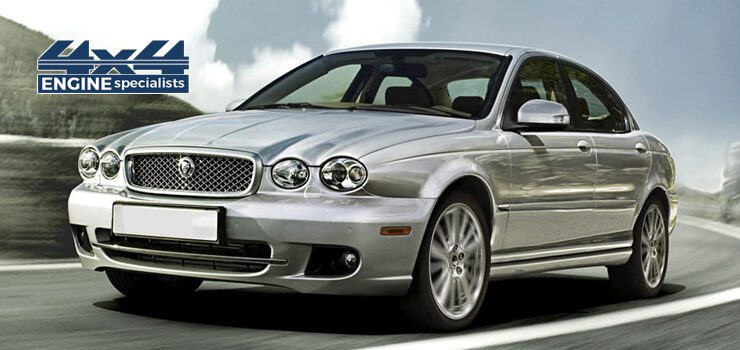The Jaguar X-Type, a luxury sedan introduced by the British automaker, boasts an impressive combination of style, performance, and sophistication. One of the key elements defining its prowess is the range of engines available under its hood. In this article, we delve into the intricacies of Jaguar X-Type engines, exploring their specifications, performance, and the driving experience they offer.
Petrol Engines
The petrol engines for the Jaguar X Type were sourced from Ford’s Duratec family of engines. They were all aluminium, DOHC, 24-valve engines with variable valve timing and electronic throttle control. The petrol engines were:
2.0-litre V6:
This engine produced 157 hp and 200 Nm of torque. It was only available with a five-speed manual transmission and front-wheel drive. It had a fuel consumption of 9.8 L/100 km and a CO2 emission of 234 g/km.
2.5-litre V6:
This engine produced 194 hp and 244 Nm of torque. It was available with either a five-speed manual or a five-speed automatic transmission and four-wheel drive. It had a fuel consumption of 10.5 L/100 km and a CO2 emission of 249 g/km.
3.0-litre V6:
This engine produced 231 hp and 300 Nm of torque. It was available with either a five-speed manual or a five-speed automatic transmission and four-wheel drive. It had a fuel consumption of 10.8 L/100 km and a CO2 emission of 254 g/km.
The petrol engines offered smooth performance, refined sound and good acceleration. However, they were also criticized for being thirsty, heavy and outdated compared to the rivals.
Diesel Engines
The diesel engines for the Jaguar X Type were sourced from Ford’s Duratorq family of engines. They were all iron block, DOHC, 16-valve engines with common rail injection and turbocharging. The diesel engines were:
2.0-litre TDCi:
This engine produced 128 hp and 330 Nm of torque. It was only available with a five-speed manual transmission and front-wheel drive. It had a fuel consumption of 5.8 L/100 km and a CO2 emission of 152 g/km.
2.2-litre TDCi:
This engine produced 152 hp and 360 Nm of torque. It was available with either a six-speed manual or a six-speed automatic transmission and front-wheel drive. It had a fuel consumption of 6.1 L/100 km and a CO2 emission of 159 g/km.
The diesel engines offered better fuel economy, lower emissions and more torque than the petrol engines. However, they were also criticized for being noisy, rough and lacking in refinement compared to the rivals.
Four-Wheel Drive System
The four-wheel drive system for the Jaguar X Type was based on the Ford Control Trac system, which was also used for the Ford Explorer and the Ford Escape. The system used an electronically controlled centre differential that could vary the torque distribution between the front and rear axles from 100:0 to 50:50 depending on the road conditions and driving style. The system also had an anti-lock braking system (ABS), traction control system (TCS) and dynamic stability control (DSC) to enhance the stability and handling of the car.
The four-wheel drive system offered better grip, traction and confidence on slippery or uneven surfaces than the front-wheel drive system. However, it also added weight, complexity and cost to the car.
Transmission Options
The transmission options for the Jaguar X Type were:
Five-speed manual:
This transmission was only available for the 2.0-litre V6 petrol engine and the 2.0-litre TDCi diesel engine.
Six-speed manual:
This transmission was only available for the 2.2-litre TDCi diesel engine.
Five-speed automatic:
This transmission was available for the 2.5-litre and 3.0-litre V6 petrol engines. It had a sport mode that allowed manual shifting using the gear lever or steering wheel paddles.
Six-speed automatic:
This transmission was available for the 2.2-litre TDCi diesel engine. It had a sport mode that allowed manual shifting using the gear lever or steering wheel paddles.
The transmission options offered different levels of performance, comfort and convenience, depending on the engine and the driver’s preference.
Engine Problems and Reliability
The Jaguar X Type engines were generally reliable and durable, as long as they were properly maintained and serviced. However, some common problems and issues that could affect the engines were:
Oil leaks:
The petrol engines could develop oil leaks from the valve cover gaskets, the oil pan gaskets or the oil cooler hoses. The diesel engines could develop oil leaks from the turbocharger seals, the injector seals or the oil filter housing.
Timing belt:
The diesel engines had a timing belt that needed to be replaced every 160,000 km or 10 years, whichever came first. A timing belt failure may seriously harm the engine.
Fuel pump:
The diesel engines had a high-pressure fuel pump that could fail due to wear and tear or contamination. If the fuel pump failed, it could cause poor performance, hard starting, stalling or engine failure.
Glow plugs:
The diesel engines had glow plugs that helped to start the engine in cold weather. If the glow plugs failed, it could cause hard starting, rough idling or white smoke from the exhaust.
EGR valve:
The diesel engines had an exhaust gas recirculation (EGR) valve that reduced emissions by recirculating some of the exhaust gas back into the intake manifold. If the EGR valve became clogged or stuck, it could cause poor performance, increased fuel consumption, black smoke from the exhaust, or an engine warning light. Get the best information about the Range Rover Engines visit us at https://4x4enginespecialists.co.uk/ .
Engine Tuning and Upgrades
The Jaguar X Type engines could be tuned and upgraded to improve their performance, efficiency and appearance. Some of the possible modifications and enhancements were:
Air filter:
Replacing the stock air filter with a high-performance one could increase the airflow and horsepower of the engine.
Exhaust system:
Replacing the stock exhaust system with a sportier one could reduce the back pressure and increase the sound and power of the engine.
Chip tuning:
Installing a custom chip or remapping the engine control unit (ECU) could alter the fuel injection, ignition timing and boost pressure of the engine to optimize its performance.
– Supercharger: Adding a supercharger to the petrol engines could increase their power and torque by forcing more air into the combustion chambers.
– Intercooler: Adding an intercooler to the diesel engines could lower the temperature of the intake air and increase its density, resulting in more power and efficiency.


